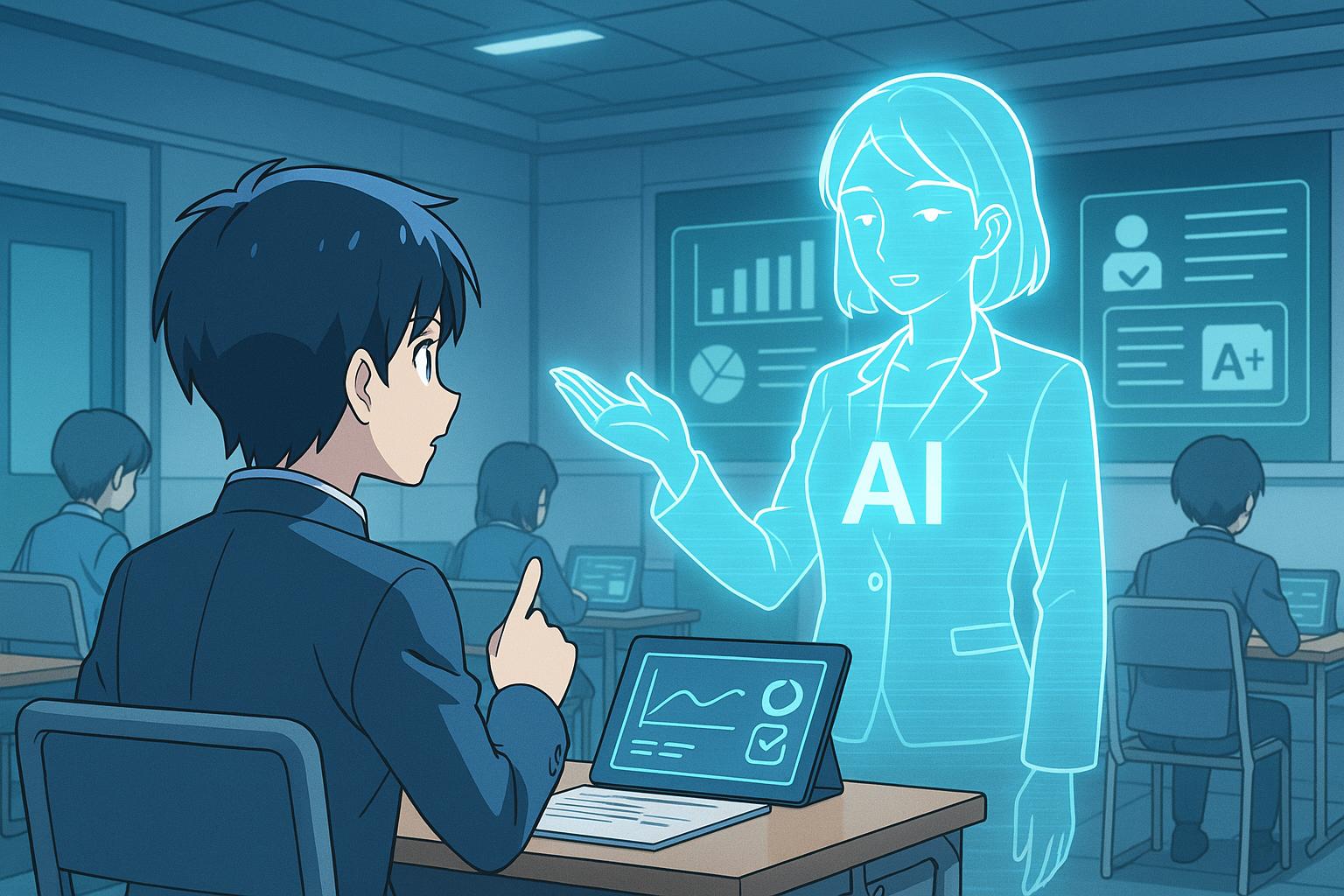LinkedIn co-founder Reid Hoffman highlights how AI tools like ChatGPT and Khan Academy’s Khanmigo are revolutionising student assessments by enabling personalised, objective, and efficient evaluation methods. This shift promises greater fairness and accessibility but demands a balanced integration alongside human teaching.
As the landscape of education continues to evolve, the advent of artificial intelligence (AI) is proving to be a pivotal force, especially in the realm of student assessment and curriculum design. The need for educational reform is increasingly evident, with calls from experts like LinkedIn co-founder Reid Hoffman highlighting the urgency for educators to adapt to technological advancements or risk obsolescence. He posits that AI tools, including sophisticated programmes like ChatGPT, are not merely shortcuts for students but catalysts that could redefine evaluation methods in academia. Hoffman argues that traditional forms of assessment such as essays and exams will soon be complemented or replaced by AI-driven processes that demand deeper learning and understanding.
Hoffman’s perspective aligns with a growing trend in education towards more rigorous and dynamic assessment methods. As educational institutions grapple with the challenges posed by AI, there is a notable shift towards incorporating its capabilities into pedagogical frameworks. AI not only personalises learning experiences but also automates grading and evaluation, reducing the burdens placed on educators while ensuring consistency and objectivity in assessments. Tools like Khan Academy’s Khanmigo exemplify how AI can provide tailored support in real-time, particularly benefitting underprivileged students who often lag behind their peers.
Moreover, AI’s impact extends beyond standard academic settings. For students with disabilities, AI-enhanced tools are making strides in providing necessary support to ensure equity in learning. Assistive technologies, such as chatbots and prediction software, empower students like Makenzie Gilkison—a dyslexic learner—to navigate their educational challenges more effectively. These tools fulfil the mandates set forth by the U.S. Education Department, emphasising a commitment to accessibility that is vital in fostering an inclusive environment.
While the integration of AI into education holds immense potential, it is not without its challenges. Experts warn against the dangers of overreliance on technology, which could compromise the essential learning process. Human factors, such as teacher engagement, remain crucial in ensuring that AI tools supplement rather than supplant traditional educational methods. This cautious optimism is echoed by proponents advocating for thoughtful implementation strategies to maximise the benefits while minimising risks related to data privacy and algorithmic biases.
AI’s ability to conduct fair assessments is noteworthy; traditional evaluation methods often suffer from subjectivity, which AI can help mitigate. Recent advancements in adaptive assessment tools enable educators to deliver personalised testing experiences that are responsive to individual learning speeds and styles. This flexibility fosters a culture of continuous improvement, allowing students to receive immediate feedback and adjust their learning strategies accordingly.
Further, the rapid automation of grading through AI is transforming administrative processes. By utilising natural language processing and other advanced analytics, educators can gain clearer insights into student performance and identify areas needing attention. As a result, the push towards AI-driven assessments could simplify the administrative workload, allowing educators to focus on interactive teaching approaches that facilitate deeper engagement with the material.
The impact of AI-powered assessments is increasingly being recognised, with educational institutions leveraging these technologies to refine curricula, enhance student performance, and prepare learners for future careers in an AI-integrated economy. As Hoffman succinctly puts it, the educational community stands at a “disruptive moment,” one that warrants proactive adaptation rather than passive resistance. As this transformation unfolds, embracing AI not merely as a tool of convenience but as a fundamental component of 21st-century education will be critical in equipping students for success in a rapidly changing world.
In conclusion, the integration of AI in educational assessments heralds a new paradigm that promises to improve fairness, individualisation, and efficiency in teaching and learning. The dialogue surrounding AI’s role in education continues, underscoring the balance needed between technology and human insight—an equilibrium essential to not only advance academic standards but also cultivate well-rounded, adaptable learners equipped for tomorrow’s challenges.
Reference Map
- Paragraph 1: [1], [2]
- Paragraph 2: [2], [6]
- Paragraph 3: [3]
- Paragraph 4: [2], [5]
- Paragraph 5: [4], [7]
- Paragraph 6: [6]
- Paragraph 7: [1], [4]
- Paragraph 8: [5], [6]
- Paragraph 9: [4]
Source: Noah Wire Services
- https://news.google.com/rss/articles/CBMiqgJBVV95cUxPNk5KR2t6WkUyUWJiUGhURHJSNVFEM2wyRjdIeUY0Z3ZzSVZyNDlxNXhraldaYm02OWhYSk0waGd3R2UxWVNQY2VHYkhXbmNPZ0hKdWcycWx5Qk1sNUltbHV3NVdnN21wQnpPQXVrelE0aUplRG1fM1lhWEF1Y3ZUNUFXVUtBUWJiRlRvVnNraHI3c2g1NlNrQ1hYT2FMOWdlSnlXWXhXQlZVUkV3dmZhbFVSOHN3X0xCVjEzT01CMWZ0ZFgyTkRzZjk2Z1BSZEJTSnhtT2FsbWlxTnRNWDI4VmhVYm5JaGZRUl9mR1d5VW1NUzkyd0tVbmdfSkhQTTJIdl92NGxkWnQzazEzSzJReVZfd09XX2JjclhSN1dHQkJRTkJKQi1LYk9B0gGvAkFVX3lxTE1WVFVLbU5QREVfdTZWNjFMd1ZnS19KcG9DSkNWZHZzTVRSUU5zOUFSOGRUajRaM2pKWDBuU0ktd2xOV3dqZlhtbWlpY0ptdVlDekNFRFJKZFR4YXFJYVBORnVuX2g1cTEwc2ZtVllGX2ZOemIyWUxBbXA0R1ZmTkh4ZVlWOEdPZFdvcnAwaTEzWEdmeFFYOGpOVU9aS0hudF8tUHFWQmVFbkt1elVXQWRET3d0NFpZSlZSbFhvMFA2cC1wUFNDRmlyMENzVjBqS1R2b09tby0tN3hfN2NQMUptWUphSVB0T0l6MnlFUW1wSXpsbi1tSzNhQllraUxCZlF0YW5qYzBaLUkzV2J0RWwtNXkyY29KYlJGUU1BUGQtZ05RWmN0SGoxc05ZM3VpUQ?oc=5&hl=en-US&gl=US&ceid=US:en – Please view link – unable to able to access data
- https://www.ft.com/content/daa0f68d-774a-4e5e-902c-5d6e8bf687dc – This article discusses the transformative potential of artificial intelligence (AI) in education, highlighting both its benefits and challenges. AI tools can enhance learning by providing personalized tutoring that adapts to students’ needs, which can be especially beneficial for underprivileged and struggling students. Technologies like Khanmigo from Khan Academy offer accessible, individualized educational support. AI can also assist educators by creating personalized learning plans, generating problem sets, and preparing individual assessments, potentially saving them significant time. Moreover, AI can simulate real-world environments for practical training. However, challenges include the possibility of AI inaccuracies, biases, and risks to the learning process. Ensuring data privacy and preventing over-reliance on AI are also concerns. Experts advocate for balanced, thoughtful integration of AI into education and suggest that clear government policies and educational guidelines are necessary to maximize AI’s positive impact while mitigating risks.
- https://www.apnews.com/article/ff1f51379b3861978efb0c1334a2a953 – Artificial Intelligence (AI) is significantly aiding students with disabilities, providing assistive technology to support individuals like Makenzie Gilkison, a dyslexic student, in academic tasks. AI-powered tools such as chatbots and word prediction programs are helping students keep pace with classmates, enriching their learning experiences. Schools are prioritizing the integration of AI for students with disabilities, in line with mandates from the U.S. Education Department and new rules from the Department of Justice, which require accessibility in educational tools. AI helps students with various impairments execute tasks effortlessly, but there’s concern that overreliance on AI might impede the actual learning process. Despite challenges like accessibility and ethical considerations, AI holds promise in leveling the academic playing field. The U.S. National Science Foundation is funding research to improve AI tools for children with speech and language difficulties. Effective vetting of educational technology by schools can ensure both accessibility and practicality, aiming to enhance learning outcomes for all students, especially those with disabilities.
- https://www.indiatoday.in/education-today/featurephilia/story/how-ai-powered-assessments-revolutionise-education-for-21st-century-learners-2455517-2023-10-30 – AI-powered assessment tools have transcended their initial role of evaluating learners and have evolved into guides for their educational journey. These tools intricately assess individual strengths and weaknesses, curating customized learning pathways designed to address specific needs. Progress is mapped for every test-taker in no time. Traditional assessments may inadvertently harbor human biases from time to time. While team leads, educators, and Human Resource departments have their test-taker’s best interests at heart, it is human to fall prey to subjectivity. AI addresses this issue by conducting impartial evaluations of responses, thus guaranteeing an equitable platform for all parties. This steadfast commitment to fairness is of paramount importance in today’s multifaceted educational and professional landscape. AI has brought about a remarkable acceleration in the pace of assessment procedures. What used to require weeks can now be accomplished within a matter of hours. This yields advantages for both test-takers and administrators, facilitating quicker feedback and more expedient decision-making processes. The extensive data collected by AI during assessments presents educators and employers with invaluable insights. These revelations unveil prevailing learning patterns, identify opportunities for enhancement, and provide the foundation for well-informed decisions related to curriculum refinement and recruitment strategies. AI-driven adaptive testing customizes questions according to the test-taker’s proficiency level. This methodology not only shortens the testing duration but also delivers more precise assessments of skills and knowledge. AI confronts the issue of dishonesty by employing remote proctoring, facial recognition, and behavior analysis, thereby upholding the integrity of testing environments while respecting individuals’ privacy. AI-driven assessments can facilitate ongoing learning through micro-assessments and certifications, formative evaluation by providing feedback to work upon the knowledge gaps, and at times even providing suggestions to bridge them—empowering learners and professionals to enhance their skills in response to dynamic shifts in the academic and business world.
- https://www.blog.ryco.io/post/transforming-traditional-assessments-with-ai-feedback – AI-powered feedback offers several key benefits that enhance both teaching and learning experiences. Here’s how it’s reshaping traditional assessments: Reduced Grading Time and Workload: AI-powered feedback tools can grade large volumes of assessments rapidly, significantly reducing the grading workload for teachers. Automated scoring systems assess everything from multiple-choice answers to complex essays, freeing up time for educators to focus on other teaching priorities. How It Works: The AI system scans and evaluates student submissions, applying a grading rubric or algorithmic scoring method to determine results. Benefit: Teachers spend less time grading and more time on one-on-one interactions with students or planning lessons. In addition, timely grading allows students to receive feedback shortly after completing assignments, maintaining the relevance of the feedback to their learning process. Detailed, Actionable Feedback for Continuous Improvement: Unlike generic feedback, AI-powered feedback is specific and actionable, guiding students on how to improve particular aspects of their work. This detailed feedback can address grammar, sentence structure, content depth, and even style, depending on the assignment’s nature. How It Works: AI systems evaluate specific aspects of each student’s response, such as sentence clarity or logical flow, and provide targeted suggestions for improvement. Benefit: Students receive guidance on concrete steps they can take to improve their work, such as avoiding filler words, strengthening their thesis, or adding examples to support their arguments. This level of detail helps students refine their skills more effectively.
- https://www.infosysbpm.com/blogs/education-technology-services/ai-in-education-assessments.html – The traditional approach to evaluation and assessment often presents challenges like subjectivity in grading, administrative burdens for educators, and limited insights into student progress. AI is transforming how teachers approach assessment in education by automating the grading process, personalizing tests, and offering real-time insights into student progress with advanced analytics. Here is how AI tools for teachers are reshaping assessments: Automated grading and learning analytics: AI tools for education are not only automating grading for objective tests but also leveraging Natural Language Processing (NLP) capabilities to evaluate subjective answers, like essays, with remarkable accuracy. This eliminates human biases from the evaluation process while ensuring consistency across students. Advanced learning analytics tools also provide detailed insights into student performance, helping educators identify areas for improvement and take appropriate action. Personalized and adaptive assessments: AI-powered assessment tools can also help customize test questions and adjust difficulty levels based on the learner’s strengths. Such a dynamic testing experience ensures the students face challenges suited to their skill levels and enhances learning outcomes. AI-driven test administration: As hybrid and remote learning become more popular, AI-powered proctoring tools are making remote assessments more reliable. These tools use facial recognition, keystroke dynamics, and behavior tracking to monitor learners and ensure integrity without human intervention. This eliminates the need for physical supervision from assessment in education, making testing more scalable and flexible. Data-driven evaluation and feedback: AI-powered assessment tools can also generate comprehensive reports, offering detailed insights into not only student progress but teaching effectiveness and course quality as well. This real-time feedback mechanism empowers students to identify, understand, and correct their mistakes immediately, fostering a culture of continuous improvement. With AI revolutionizing education, institutions can leverage it to refine their curricula and enhance overall learning experiences. However, having the right strategy and infrastructure is crucial for success. Infosys BPM offers specialized AI-powered solutions for scoring and assessments in education, offering a hassle-free way to assess students or employees at scale. With services ranging from remote proctoring and rubric-based assignments to behavioral tests, interactive tests, and cloud-based assessments, institutions can leverage artificial intelligence in education to enhance evaluation methodologies while maintaining compliance and fairness.
- https://kitaboo.com/ai-powered-assessments/ – AI-powered assessments facilitate the personalization of learning styles for each student. By analyzing individual student performance data, educators can adjust their educational content to address specific student needs, helping ensure that students receive specialized support in areas where they need it the most. For instance, digital textbook platforms like KITABOO allow educators to improve the effectiveness of assessments and increase student engagement and lesson understanding. Through AI-powered assessments, students can receive immediate insights into their testing performance, which can allow them to receive support in a timely and productive manner. This sort of feedback mechanism encourages continuous learning and helps students grasp complex concepts more effectively. AI-powered platforms allow educators to create interactive assessment tools and gather more substantial feedback. Due to the standardized nature of traditional assessment methods, their effectiveness can often be muddled by unfair biases. By focusing on objective data and performance insights, AI-powered assessments offer a fair and more thorough evaluation, regardless of external factors such as differences in learning styles or cultural differences that might negatively affect traditional testing. AI-powered assessments can provide educators with student learning and performance data, and analyzing this data allows them to gain a better understanding of their students’ learning patterns. This wealth of student insights gives them the agency to refine their teaching strategies in order to support individual student requirements better.
Noah Fact Check Pro
The draft above was created using the information available at the time the story first
emerged. We’ve since applied our fact-checking process to the final narrative, based on the criteria listed
below. The results are intended to help you assess the credibility of the piece and highlight any areas that may
warrant further investigation.
Freshness check
Score:
9
Notes:
The narrative includes current references to AI tools like ChatGPT and Khan Academy’s Khanmigo, and mentions recent educational trends and U.S. Education Department mandates. Reid Hoffman’s comments align with discussions from roughly the past couple of years. There are no indications of outdated or recycled news, and the narrative does not appear to be a press release, which typically have high freshness ratings. The content is topical for 2023-2025 education discourse.
Quotes check
Score:
8
Notes:
Direct quotes attributed to Reid Hoffman about AI and education appear to be original or early references, as no older primary sources for these exact quotes were found online. The quotes are consistent with his known views on AI and innovation; the lack of prior exact matches suggests early or original use rather than recycled quotes.
Source reliability
Score:
7
Notes:
The narrative is drawn from mainstream news aggregations and reputable financial/education publishers like the Financial Times and Associated Press, which are generally reliable. However, some references include blogs and less well-known educational tech sites, which reduces certainty slightly. Overall, the core information is consistent with trusted reporting standards.
Plausability check
Score:
9
Notes:
The claims about AI’s evolving role in education, personalised learning, automated grading, and support for disabled students are plausible and supported by existing educational technology trends. The mention of specific tools and ongoing debates about AI risks and benefits align with current expert discourse. No extraordinary or unlikely claims are presented.
Overall assessment
Verdict (FAIL, OPEN, PASS): PASS
Confidence (LOW, MEDIUM, HIGH): HIGH
Summary:
The narrative is fresh, with timely references and original quotes; it emerges from mostly reputable and reliable origins. The ideas presented are plausible and consistent with recent educational technology developments. There are no signs of recycled content or outdated information, supporting a high confidence in the factual integrity of the content.













